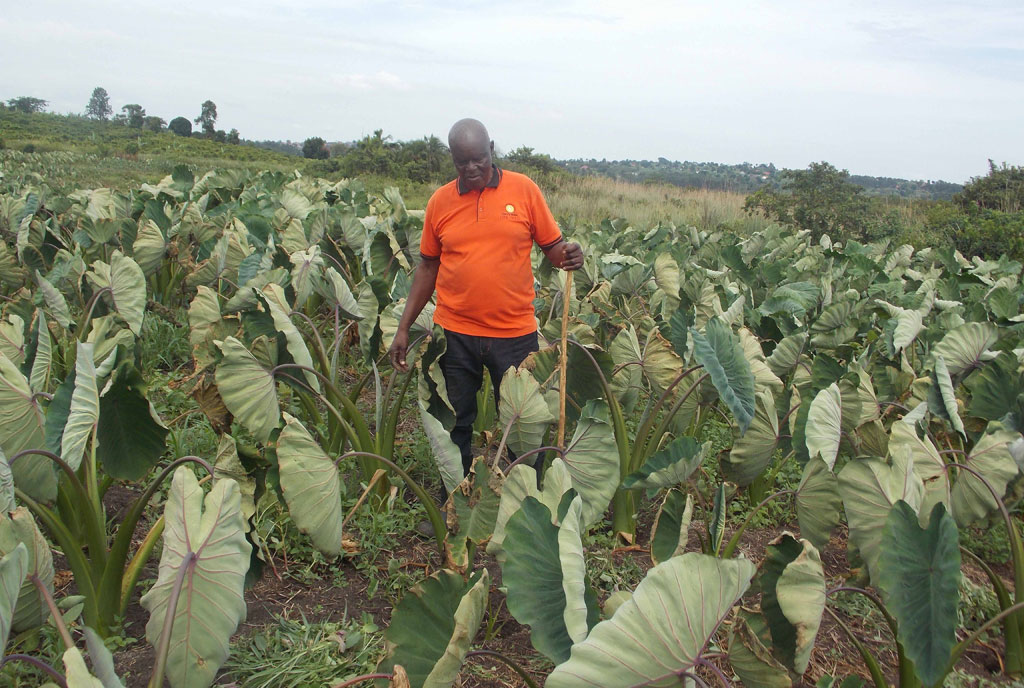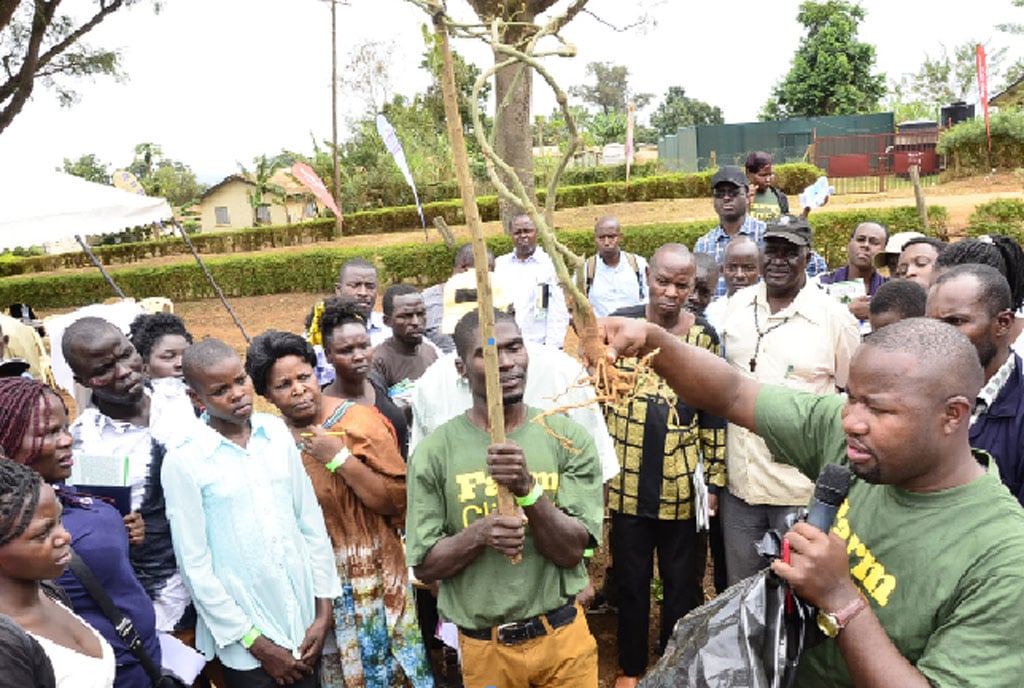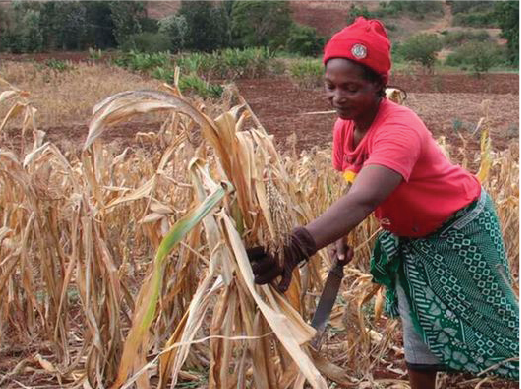
Gerald Ssendaula inspects his field of arrow roots. PHOTO/MICHALE J SSALI
|Farming
Prime
Investing in different crops for regular income
What you need to know:
- Besides coffee, Gerald Ssendaula grows maize, pineapples, vegetables, fruits, rears pigs, goats and keeps both beef and dairy cows.
- Dressed in a grey shirt, blue trousers and a matching hat, the former minister looks like any other ordinary farmer.
- He keeps track of everything that goes on in the farm, though, he has employed a manager and several other workers.
Gerald Ssendaula, a former Finance Minister is a man with many interesting farming ideas.
The retired politician recently told Seeds of Gold, “Growing maize is a quite common farming activity. This is the same with growing coffee or keeping livestock. These are some of the most common farming activities that people undertake when they set out as farmers. But I think the thinking has got to change so that we try production of some other crops which can also bring in large sums of money if given sufficient attention.”
Ssendaula has always been a large scale farmer since he left Barclays Bank where he was General Manager decades ago owning square miles of land on which he has been growing different crops and keeping livestock.
He does not disclose how many heads of cattle or goats or pigs he owns but, as a visit to any of his ranches will reveal, he has them in very big numbers.
The former banker who is the chairman of National Union of Coffee Agri-businesses and Farm Enterprises (NUCAFE) is a large scale coffee farmer who is also engaged in production of many other crops.
He keeps hundreds of Boran cattle, hundreds of dairy cattle, and, perhaps, a thousand goats on his different ranches. He also owns what he refers to as “a city of pigs” on one of his pieces of land in Mpigi, Lwengo, and Rakai districts.
Other crops
“Coffee farming or livestock keeping are the common things that most people think of when they choose to become farmers,” he says, “but there are lots of other alternative farming activities for those who have the land to invest in.”
At his Kaabagala farm in Lwengo District, Ssendaula is a large scale producer of crops such as arrow root (York Yam), pumpkins, eggplant, pineapples (red Spanish) green pepper, water melon, tomatoes, onions, climbing beans, and a whole range of vegetables and fruit crops.
He has apparently made a good survey of the different food crops sold in the Ugandan local markets and he has heavily invested in producing the food crops actually neglected by most large scale farmers and researchers.
Pumpkins
“I regularly receive traders, right here on my farm, coming to buy pumpkins at three thousand shillings each,” he told Seeds of Gold.
“Pumpkins are today some of the best money generating crops. The traders take them on trucks to Kampala. They are the type of crops on which the farmer hardly spends anything in terms of inputs such as fertilisers or pesticides.”
His pumpkin field which is perhaps three or four acres is all covered with thick green leaves hiding hundreds and hundreds of pumpkins under them. He said he does not apply any fertilisers to the soil because it is naturally fertile. Information available on Google indicates that pumpkin leaves convert sunshine, water, and carbon dioxide into food that the plant can use to produce leaves, roots, flowers, and pumpkins. After planting the seeds it normally takes between three and four months for the farmer to harvest pumpkins.
How to plant pumpkins
However Kato Jude, a sales manager at BMT Farm Limited, Isingiro District says that application of organic fertilisers is advised for best results, especially where one wants to grow pumpkins as a business. The seeds are planted in holes about two feet deep and two feet by two feet wide.
Kato whose farm displayed huge pumpkins at the recently held Powesa Agribusiness Show in Masaka also says two or three pumpkin seeds should be planted in holes spaced three by three meters. Pumpkins are always thirsty for water, but too much water or rain may cause the crop to soften and rot.
Pineapples
Ssendaula has also embarked on mass production of a rare type of pineapple --- the type whose leaves are all thorny and reddish and usually grow as individuals and quite different from the large Smooth Cayenne type that is commercially grown all over East Africa. They are however very sweet although they tend to be smaller than the type we commonly see in our markets.
To get seedlings of the rare pineapple cultivar he made an order for them from AGT laboratory at Buloba which supplied him with tissue culture planting material.
Tissue culture technology
Right now he has planted the tissue culture seedlings as mother stock on about an acre of land from which he hopes to get enough pineapple suckers to plant a field some ten acres wide.
“They are very sweet and my target includes several hotels that will use them to prepare desert and fruit salads for their guests,” he revealed. He also believes that they will be greatly demanded in all our markets because of their unique sweet taste.
One of the reasons he gives for diversification of his farm enterprises is constant cash flow.
“I need money every day. To increase my chances of getting money daily I must engage in multiple crop production,” he says.
His market
It is the reason he grows a variety of crops. Most of the buyers of his crops are female food vendors in nearby Kinoni Town although, time and again, he has buyers from as far away as Kampala and Masaka to purchase such commodities as water melon, tomatoes, beans, eggplant, onions, pumpkins, arrow root, and maize.
Why mixed farming
The big advantage with diversification of farming enterprises which Ssendaula practices is that if one enterprise does not give good yields the others will most probably do. There is reduced risk of total crop failure and loss of income from the farm. It must however be born in mind that only farmers working on very large pieces of land can afford to engage in this kind of enterprise diversification.
He has about three acres of climbing beans locally known as masavu. When Seeds of Gold arrived at the farm he was busy inspecting the field where the climbing beans vigorously grew on poles.
He was also overseeing labourers that were digging holes and putting up more poles for supporting more climbing beans. He owns a large forest of eucalyptus trees right adjacent to where the beans are growing and the labourers did not have to go very far to get the best poles for the climbing beans.
Since he has the irrigation system on the farm which is located close to Kyoja Swamp he did not seem bothered about the likely shortage of rain this February.
Why mixed farming
The big advantage with diversification of farming enterprises which Ssendaula practices is that if one enterprise does not give good yields the others will most probably do. There is reduced risk of total crop failure and loss of income from the farm.
Pineapples
Gerald Ssendaula has also embarked on mass production of a rare type of pineapple - the type whose leaves are all thorny and reddish usually growing as individual rather neglected plants in banana gardens quite different from the large Smooth Cayenne type that is commercially grown all over East Africa.




